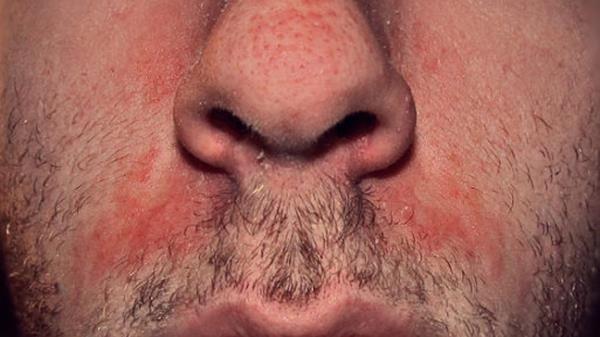I am 27 years old, with fair skin, and currently 35 weeks pregnant. Over the last 2-3 weeks I have developed a strange rash/spot of sorts on my face. It began as a small, reddish patch (looked kind of like a small abrasion) on my left cheek, about 3/4 inch below the outside corner of my left eye. It slowly grew over about 5-7 days. It was red, became slightly raised, and was almost perfectly round. It may have had a very faint reddish border, or it may have just been the raised edges that made it appear so. Anyway, it finally reached about the size of a dime. The inside was *very* slightly dry/flaky, and it would only occasionally itch a *very* little bit (almost so as not to be noticed). I tried applying Neosporin from the time I first noticed it -- it didn't seem to have much of an effect. However, after growing to dime-sized, it slowly cleared up. After 3 or 4 days, it was gone.
Then, about 3 or 4 days after it had disappeared, the whole process began again. Exact same spot; it slowly grew (perhaps it was a little bit larger the second time and a little less perfectly round); but overall the same development. I went to my primary care physician, who took a small scraping from it and looked at it under a microscope. He said he couldn't clearly see a fungus, but also couldn't identify it as anything else. He recommended trying Miconazole 2% (Monistat) on it for two weeks. Well, I began applying it, and once again -- about 7-8 days after it reappeared -- it cleared up over 3-4 days. I have, however, continued to use the Miconazole. Nonetheless, the spot is now reappearing, in the same spot..
I am hoping to get referred to a dermatologist, but in the meantime, wonder if you have any suggestions as to what this might be? What kind of rash can come and go, in the exact same spot, like this? Could it be a strange side-effect of the pregnancy? Is it likely to spread or keep getting bigger?
Please help! -- this rash (or whatever it is) in addition to all the normal problems of pregnancy is really stressing me out. I assume it's not eczema/psoriasis because it doesn't really itch; it doesn't seem to be a fungus or bacterial because it hasn't responded to either an anti-fungal cream or Neosporin. I'm worried if it's something that could have an effect on the baby. I've also read that some immuno-deficiency disorders (like lupus, etc.) can cause rashes on the face. Could this be one of those??
Thank you,
L.
Seborrheic dermatitis is a common skin condition that causes a red rash, which often appears on the face. The rash may cause the skin to look oily as shown here. The skin can also appear dry and scaly. What can get rid of the redness: Seborrheic dermatitis usually requires treatment to clear. After all, many descriptions of skin cancer are similar to that of seborrheic dermatitis: 'Rough, red patch on the nose or cheek.' Or, 'Rough, scaly dry red or pink patch on the skin.' This is a generic description of how non-melanoma skin cancer can present, but it also fits the description of seborrheic dermatitis.
The perceived wisdom when it comes to melanomas is to medically check or refer any new mole or pre-existing mole which changes in appearance. The word, ‘melanoma', actually means, ‘malignant mole'. Moles are usually brown or black but not every melanoma is that colour or a variant hence the reason to seek a professional analysis of a new raised area of skin or blemish or lesion that does not seemingly have an obvious underlying cause i.e. a wound, bite, sting, bruise or just good old-fashioned spots. Potentially troublesome moles may exhibit a purplish/blue hue but this is not the only shade of melanoma.
Can melanomas be red in colour?
One of the mechanisms used for non-qualified people to spot a mole that is different is the ‘ugly duckling' principle. Most people's moles are consistent for their body so a similar tone and shape which may differ from the next person's. A mole that stands out as different requires investigation. It may vary from your usual colour, the shape may seem unusual and it may lack symmetry, so –odd-shaped.
Melanomas can be red and are described as amelanotic melanomas. Usually not deriving from moles and absent melanin, therefore, they can be easily mistaken for something harmless. They are commonly misdiagnosed as they remain challenging to identify even for an experienced clinician. They appear as a new presentation on the skin or an existing one which is undergoing a transformative process.
How difficult is it to detect a pink melanoma?
For those with fair skin, a light pink melanoma will hardly register, surely just a variation in skin tone. They may be noticeable as new arrivals but hardly present as a cause for concern. Read this online account by West Australian nurse, Amanda Whittle. Fortunately, her pink melanoma was spotted and treated. Australians put the rest of the world to shame when it comes to vigilance over melanomas. A largely fair-skinned population in a climate defined by glorious weather, they have regular skin inspections. It is compulsory for school children to wear sunhats and carry sunscreen and beachgoers wear special swimming costumes that actually block out all ultraviolet light, even the adults. Genius!
Do Lentigines have any connection to white melanomas?
More commonly entitled sunspots, liver spots or age spots, they have no association with the function of internal organs but do have a tendency to appear on older people who have spent a lifetime in the sun for work or leisure purposes. A Lentigo Maligna Melanoma occurs from a pre-existing lentigo, not a mole. These incidences are infrequent, accounting for less than 5% of melanoma cases and have a slow developing propensity. Most prominent on the face or back, in male outdoor workers, they are typically large and flat presenting as either grey or white melanomas. Preseti dlya adobe premiere cc.
Melanoma prevention and good sun habits

Like lung cancer and its relationship with smoking, melanoma can be massively reduced in risk or totally eliminated with good regimens, especially important for young children with delicate and vulnerable skin. You don't have to miss out on the fun in the sun, just follow the tagline or slogan of the American Cancer Society, ‘Slip! Slop! Slap! and Wrap!' which means, in essence, put on a shirt, lather on some high factor total block, pop a hat on your head and wrap around the sunshades to protect your eyes.
What is binge tanning?

Binge tanning is rather like binge drinking, it indicates excessive amounts of sun. This can arise in one of two ways. Overuse of tanning lamps which produce UV light several times stronger than the sun itself. The other form of abuse is exposing milky, white skin to the heat and force of foreign sunshine without any acclimatisation or protection. This is behind the alarming rise of melanoma diagnoses in the UK, noted for its grey, overcast skies and cloud cover. Currently, one woman in her twenties is being diagnosed every day. In the United Kingdom, it is the most common cancer in women under 30, overtaking both breast and cervical cancer according to Cancer Research.
Melanomas can be internal too
The greatest percentage of melanomas arises externally, visible on the skin. If they spread or metastasize, they may reach internal organs. More rarely, melanoma can develop internally without first indicating its existence on the skin.
Ocular melanoma is one such illustration, affecting structures within the eyes, which also contain pigment and those pigment-producing cells, melanocytes. Internal melanoma can also grow in the mucous membranes so the nose, sinuses, mouth, anus or vagina, so-called, Mucosal Melanoma. Make no mistake, ocular melanoma is rare, with a hit rate of five cases per one million head of population. Similarly, melanoma in the mucous membranes represents only 1% overall of all melanoma diagnoses but location and rarity deem a grave and guarded outlook when they are identified as they are often late stage.
Should a very small melanoma be taken seriously?
Melanoma does not have the reputation it deserves. It is an aggressive and deadly cancer with an almost innocuous presence belying the potential gravity of the situation. A small melanoma can hide its depth and extent beneath the skin, always get them inspected by a doctor.
Red Patch On Face That Comes And Goes Away

Like lung cancer and its relationship with smoking, melanoma can be massively reduced in risk or totally eliminated with good regimens, especially important for young children with delicate and vulnerable skin. You don't have to miss out on the fun in the sun, just follow the tagline or slogan of the American Cancer Society, ‘Slip! Slop! Slap! and Wrap!' which means, in essence, put on a shirt, lather on some high factor total block, pop a hat on your head and wrap around the sunshades to protect your eyes.
What is binge tanning?
Binge tanning is rather like binge drinking, it indicates excessive amounts of sun. This can arise in one of two ways. Overuse of tanning lamps which produce UV light several times stronger than the sun itself. The other form of abuse is exposing milky, white skin to the heat and force of foreign sunshine without any acclimatisation or protection. This is behind the alarming rise of melanoma diagnoses in the UK, noted for its grey, overcast skies and cloud cover. Currently, one woman in her twenties is being diagnosed every day. In the United Kingdom, it is the most common cancer in women under 30, overtaking both breast and cervical cancer according to Cancer Research.
Melanomas can be internal too
The greatest percentage of melanomas arises externally, visible on the skin. If they spread or metastasize, they may reach internal organs. More rarely, melanoma can develop internally without first indicating its existence on the skin.
Ocular melanoma is one such illustration, affecting structures within the eyes, which also contain pigment and those pigment-producing cells, melanocytes. Internal melanoma can also grow in the mucous membranes so the nose, sinuses, mouth, anus or vagina, so-called, Mucosal Melanoma. Make no mistake, ocular melanoma is rare, with a hit rate of five cases per one million head of population. Similarly, melanoma in the mucous membranes represents only 1% overall of all melanoma diagnoses but location and rarity deem a grave and guarded outlook when they are identified as they are often late stage.
Should a very small melanoma be taken seriously?
Melanoma does not have the reputation it deserves. It is an aggressive and deadly cancer with an almost innocuous presence belying the potential gravity of the situation. A small melanoma can hide its depth and extent beneath the skin, always get them inspected by a doctor.
